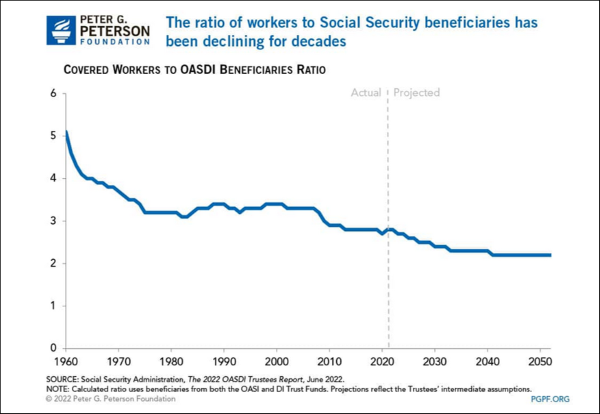(Note: This post is part of a long series, prepared in advance of leaving town on a three-week vacation.)
In 1960, there were 5.1 workers per Social Security beneficiary; that ratio has dropped to 2.8 in 2022. Here’s a chart from the Peter G. Peterson Foundation (“the Peterson Foundation”) documenting the decline:
The Peterson Foundation provides three reasons why the ratio of workers to beneficiaries has been declining:
Changes in fertility – Around the end of the baby boom in 1960, the average number of children born to a woman was 3.6; by 2020, that number had declined to 1.6. The decline in fertility rate means that the working generation is getting smaller relative to the generation receiving benefits
Immigration – Immigrants tend to be younger, have higher fertility rates, and participate in the workforce. However, the rate of immigration to the United States has been declining in recent years.
Age of the population – Simultaneously, more Americans are getting older and living longer. In 1960, an individual who reached age 65 was expected to live to 80; today that person is expected to live to 85.
Why does this matter?
Because workers support the young, elderly, and other nonworkers, aka “dependents”. A larger working-age population supports economic growth, thereby generating additional tax revenue to fund pensions, healthcare, public education and other programs that benefit the young, old, disabled, etc. Too few workers relative to dependents, the economy tanks, tax revenues plummet, and the dependents go without – majorly. And that’s where we are headed.
What can be done about it?
Increase fertility rates and legal immigration:
Increase fertility - As amply documented in my density series*, parents and wanna-be parents strongly prefer living in single-family housing (SFH) and many are receptive to smaller lots in dense SFH developments. Metropolitan areas with housing shortages need to build more of these developments (ideally low-carbon by design and power source), either within city limits or at the periphery on retired agricultural land. The amount of extra land required would be negligible, especially compared to the excess land use of organic farms and grass-fed cattle.
Of course, the shortage of suitable family housing is only one of many reasons for falling fertility rates, but fixing this problem would certainly help. The idea is to give fertility a boost, to get us a bit closer to replacement level for a stable population and a more favorable worker-to-dependent ratio.
Increase legal immigration - I’m talking about fully vetted immigrants and a tightly controlled skills-based immigration system that takes into account housing supply, prevailing wages, and labor conditions. We would also need an expanded guest worker program to fill jobs with lower skill requirements (e.g., construction laborers, farm workers, home health aides), with the promise of a green card for guest workers who meet certain requirements (eg, improved skills, education, English proficiency, etc.).
—
* The density posts:
Rethinking Density: Three Charts and a Few Comments
Rethinking Density: How to Protect Wild Habitat and have a Yard Too
Thirteen Features of Environmentally-Friendly Single Family Homes and Community Context
The Environmental Benefits of Dense Single-Family Housing Developments
Rethinking Density: Why Families Want Single Family Homes
Rethinking Density: Robbing Peter to Pay Paul
Rethinking Density, 2025 Version: Where Families and Would-Be Families Want to Live
References:
What Is the Dependency Ratio, and How Do You Calculate It? By Adam Hayes/ Investopedia Updated March 08, 2024
Minimizing the dependency ratio in a population with below-replacement fertility through immigration. Simon C, Belyakov AO, Feichtinger G., Theoretical Population Biology. 2012 Nov;82(3):158-69. doi: 10.1016/j.tpb.2012.06.009.
Demographic Turning Points for the United States: Population Projections for 2020 to 2060: Population Estimates and Projections. By Jonathan Vespa, Lauren Medina, and David M. Armstrong. Current Population Reports/U.S. Census Bureau P25-1144, Issued March 2018. Revised February 2020.
The Ratio of Workers to Social Security Beneficiaries Is at a Low and Projected to Decline Further, The Peter G. Peterson Foundation. Last Updated August 4, 2022.
